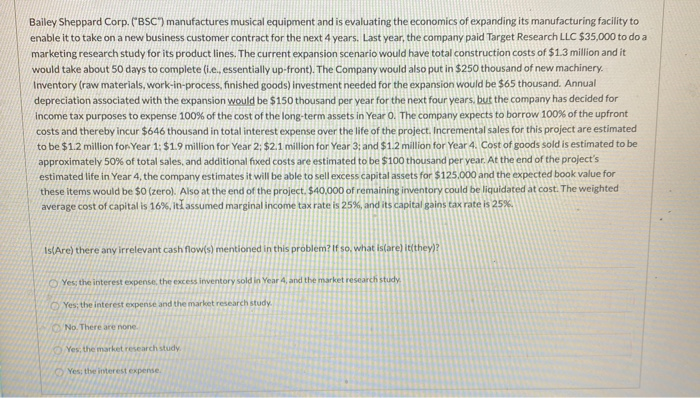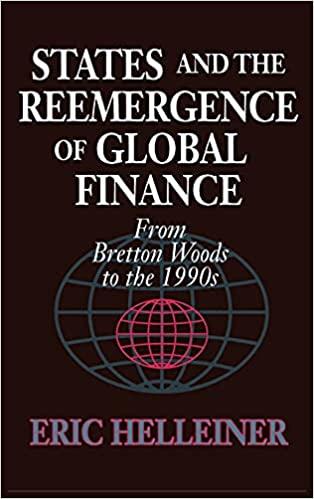Please answer all three. Thank you.

Bailey Sheppard Corp. ("BSC") manufactures musical equipment and is evaluating the economics of expanding its manufacturing facility to enable it to take on a new business customer contract for the next 4 years. Last year, the company paid Target Research LLC $35,000 to do a marketing research study for its product lines. The current expansion scenario would have total construction costs of $1.3 million and it would take about 50 days to complete lie., essentially up-front). The Company would also put in $250 thousand of new machinery. Inventory (raw materials, work-in-process, finished goods) investment needed for the expansion would be $65 thousand. Annual depreciation associated with the expansion would be $150 thousand per year for the next four years, but the company has decided for income tax purposes to expense 100% of the cost of the long-term assets in Year 0. The company expects to borrow 100% of the upfront costs and thereby incur $646 thousand in total interest expense over the life of the project. Incremental sales for this project are estimated to be $1.2 million for Year 1: $1.9 million for Year 2: $2.1 million for Year 3; and $1.2 million for Year 4. Cost of goods sold is estimated to be approximately 50% of total sales, and additional fixed costs are estimated to be $100 thousand per year. At the end of the project's estimated life in Year 4, the company estimates it will be able to sell excess capital assets for $125.000 and the expected book value for these items would be $0 (zero). Also at the end of the project. $40,000 of remaining inventory could be liquidated at cost. The weighted average cost of capital is 16%, iti assumed marginal income tax rate is 25%, and its capital gains tax rate is 25%. Is(Are) there any irrelevant cash flow(s) mentioned in this problem? If so, what isare) It(they)? Yes, the interest expense, the excess inventory sold in Year 4, and the market research study Yes, the interest expense and the market research study No. There are none Yes, the market research study Yes, the interest expense. Four years ago, your employer purchased for $2,250,000 a new office telephone system to support its complex of office buildings. Your supervisor wants to know what its after-tax salvage value would be if it were sold today and replaced with a new system. The system purchased four years ago is being depreciated straight-line for tax purposes over 5 years to a book value of $50,000 (because when the system was purchased the Company believed it could be sold for $50,000 at the end of 5 years). Your company has a 21% marginal income tax rate for capital gains. You have done some checking around and have learned this old system has a market value of $800,000. If the company could sell the old system for this price, what would be its after-tax salvage value? $734,900 $350,000 $263,500 $247,500 $853.500 8.55 pts D Question 29 You and two of your friends started a wholesale distribution business to distribute hardware and lawn and garden tools. Two years ago, your business paid $120,500 for 4 acres of land for a potential new distribution center to be built in Moore OK. Today, the market value of this land is $335.000. Your company has just analyzed a proposal to develop a new distribution center, and has determined that it will not be feasible to go forward with the proposed project. Therefore, your company will sell the land for $335,000 as planned because the proposed new distribution was determined to be infeasible. When the proposed project was being analyzed, did the land represent a relevant cash flow? Yes it was an opportunity cost and the proposed project reflected the $335.000 current market value as an opportunity cost. Yes, it was relevant to the analysis and the historical cost of the land was a sunk cost No, it was a un cost and not relevant Yes, it was an opportunity cost, and the proposed project reflected the 5214,500 net gain for the land as such









